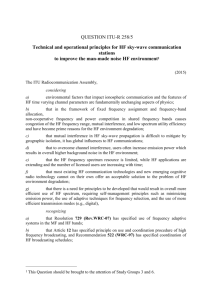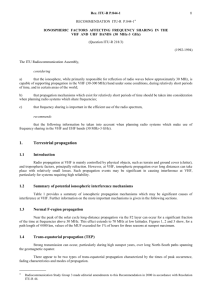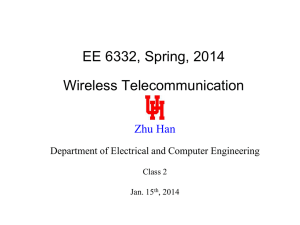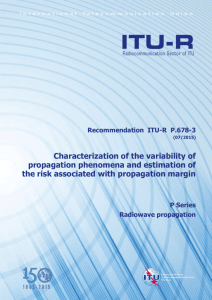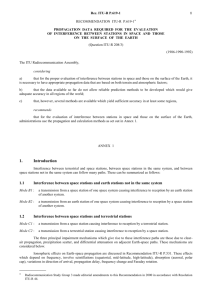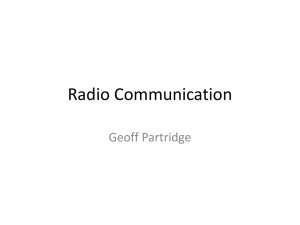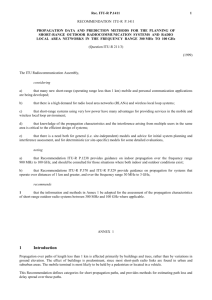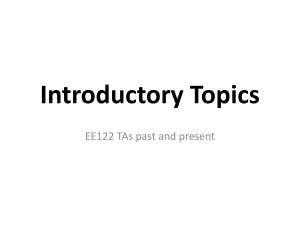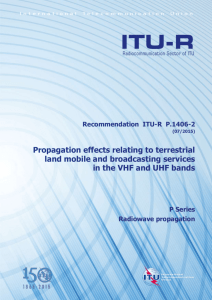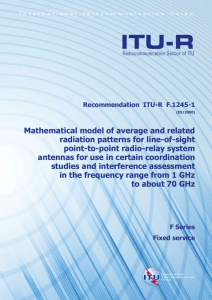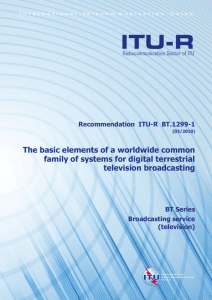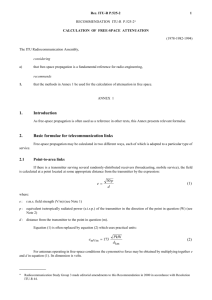Radio Wave Propagation: Fundamentals and Models
advertisement
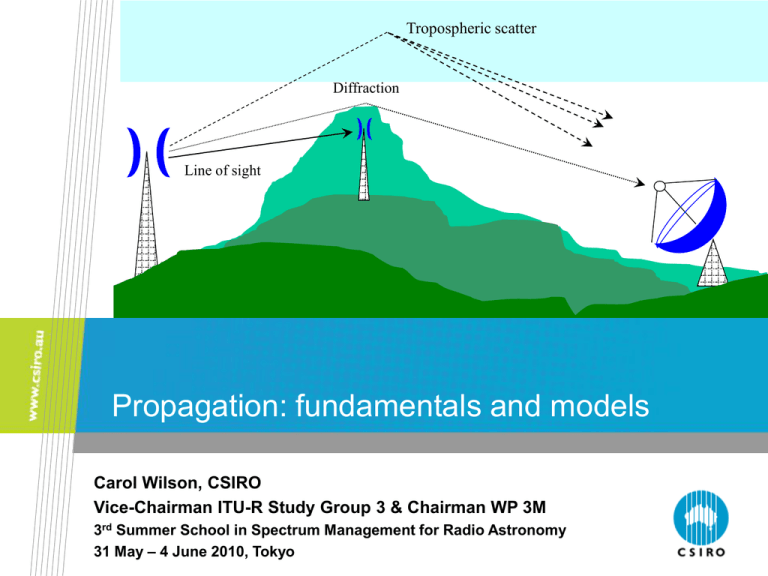
Tropospheric scatter
Diffraction
Line of sight
Propagation: fundamentals and models
Carol Wilson, CSIRO
Vice-Chairman ITU-R Study Group 3 & Chairman WP 3M
3rd Summer School in Spectrum Management for Radio Astronomy
31 May – 4 June 2010, Tokyo
Outline of presentation
• Introduction – why propagation matters
• Mechanisms of radiowave propagation and
prediction methods
• Types of models
• Software
• Conclusion
Why does propagation matter?
• Predict levels of interference from other radio
sources
• Understand variability of interference
• Assess possible interference mitigation
methods
Basic definitions
• Propagation – what happens to an radio signal as it
travels.
• Enough signal where you want it to be? (System design)
• Too much signal where you don’t want it to be? (Interference)
• Attenuation – loss due to:
•
•
•
•
Distance
Ground
Obstacles (terrain, buildings…)
Tropospheric and ionospheric variations (weather, etc)
• Loss = 10*log (Ptx/Prx) (expressed as positive number)
• Does not (generally) include antenna gain
Mechanisms of propagation
• Free space – loss due simply to distance
• Generally sets the lower bound on the loss (upper bound on
interference level)
• Mechanisms that increase loss (decrease interference)
• Diffraction (including sub-path diffraction)
• Attenuation by rain (snow, etc) and atmospheric gases
• Mechanisms that decrease loss (increase interference)
•
•
•
•
•
Reflection/refraction (ground or atmospheric layers)
Multipath in cluttered environments
Atmospheric ducting
Ionospheric sporadic-E propagation (VHF/HF)
Rain scatter
• Environment is complex and difficult (or impossible) to define in
detail uncertainty in prediction. (c.f. weather forecasting)
Interference mechanisms
Long-term effects
Tropospheric scatter
Diffraction
Line of sight
Hydrometeor scatter
Line of sight with
multipath
enhancement
Reflection/refraction
by elevated layers
Ducting
Short-term effects
ITU-R Study Group 3 Recommendations
Study Group 3 webpage:
www.itu.int/ITU-R/index.asp?category=study-groups&link=rsg3&lang=en
Recommendations:
http://www.itu.int/rec/R-REC-P/en
Go here to get three free Recommendations per year:
http://www.itu.int/publications/bookshop/how-to-buy.html#free
Updated when better methods or information is available. Use most
recent version. (Rec P.526-11 rather than P.526-10)
Relation between propagation values
Field strength for a given isotropically transmitted power:
E = Pt – 20 log d + 74.8
Isotropically received power for a given field strength:
Pr = E – 20 log f – 167.2
Free-space basic transmission loss for a given isotropically transmitted
power and field strength:
Lbf = Pt – E + 20 log f + 167.2
Power flux-density for a given field strength:
S = E – 145.8
where:
Pt :
isotropically transmitted power (dB(W))
Pr :
isotropically received power (dB(W))
E:
electric field strength (dB(mV/m))
f:
frequency (GHz)
d:
radio path length (km)
Lbf :
free-space basic transmission loss (dB)
S:
power flux-density (dB(W/m2)).
From ITU-R Recommendation P.525
Free space loss
Attenuation of signal due to distance alone.
Lbf = 20 log (4pd / l)
dB
or in practical units
Lbf = 32.4 + 20 log(f) + 20 log (d)
dB
where f is in MHz and d is in distance
For most practical situations, free space loss is the minimum loss
worst case interference.
Applicable to interference from aircraft, satellites.
Apparent “line-of-sight” paths not necessarily free space loss only!
ITU-R Recommendation P.525
Refraction through atmospheric layers
Ordinary atmospheric conditions create ray bending so that the radio
horizon is greater than the geometric horizon.
re
re
ae =k re
Modelled by use of k-factor multiplied by physical earth radius.
Median global value of k is 4/3.
Physical earth radius is ~6370 km. ae = 6370*(4/3) = ~8500 km
For antenna heights h1 and h2, line of sight distance is:
d los
2 ae
h1
h2
Recommendation ITU-R P.834
Diffraction – within line-of-sight
Not only when direct line between transmitter and receiver is
obstructed.
Subpath diffraction – due to Earth bulge on paths within line-ofsight distance if clearance is less than
h req 0 . 552
d1 d 2 λ
d
Recommendation ITU-R P.526
Diffraction – simple obstructions
Smooth earth diffraction – curvature of the Earth itself on a
transhorizon path. (Rec P.526; below 10 MHz, use Rec P.368.)
Single obstacles. Approximated as ideal knife-edge or rounded
cylinders. Methods in Rec. P.526.
h
2 1
1
l d 1
d2
Diffraction – more complicated terrain
Multiple knife-edge diffraction model:
• Used for prediction of signal level over long distances or wide areas
• Uses digital terrain map
• Simple to implement but surprisingly accurate compared to
measurements
• Used by ITU for prediction of both wanted and interfering signals
460
Height adjusted for Earth radius (m)
450
Fresnel zones
440
430
420
410
400
390
380
370
360
0
5
10
15
20
25
30
35
Distance (km)
40
45
50
55
60
65
Knife-edge diffraction model
• Terrain profile includes earth curvature and atmospheric refraction
• Diffraction parameter is a function of how far the terrain point
obstructs the first Fresnel zone radius:
n h 2 d ab / l d an d nb
• Point with largest on entire path: principal edge
• Points with largest either side of principal edge: auxiliary edges
2
J ( ) 6 . 9 20 log ( – 0 . 1) 1 – 0 . 1
dB
• Sum diffraction loss from three edges
L = J(p) + {1.0 – exp( –J(p) / 6 )} [J(t) + J(r) + 10.0 + 0.04D ]
Recommendation ITU-R P.526
Tropospheric scatter and ducting
• Scattering from inhomogeneities (troposcatter) is the main longterm effect on long paths (more than ~100 km) when diffraction
loss becomes high.
• Ducting may occur for short periods of time due to atmospheric
layers near the surface (over water or flat coastal areas) or
elevated layers in the atmosphere. May be significant for
distances up to ~ 300 km.
• Recommendation ITU-R P.452 gives an empirical calculation
method for troposcatter, ducting and reflection from
atmospheric layers.
• Scatter from rain can also calculated using Recommendation
ITU-R P.452. (May be significant above ~ 5 GHz)
Mechanisms affecting HF and VHF
• Small but intense ionization layers in the E-region of the
ionosphere (Sporadic-E) can cause abnormal VHF propagation
for periods lasting several hours. Effect decreases with
increasing frequency but can be significant up to ~135 MHz.
• Recommendation P.534 gives a method for predicting field
strength and probability of occurrence.
• At frequencies to ~30 MHz, ground wave propagation is the
major propagation mechanism.
• Recommendation P.368 gives a method for predicting ground
wave field strength, based on curves.
Ground wave 10 kHz to 30 MHz
Other propagation mechanisms
• Multipath – reflections from objects may cause distortion of
wanted signal. In some specific scenarios, may increase
interference power.
• Attenuation due to rain, clouds, fog, snow, etc. Noticeable
above about 5 GHz. Decreases wanted signal (and
interference signal). Raises noise temperature.
• Atmospheric attenuation noticeable with increasing frequency
and at specific molecular resonance frequencies. Provides
good isolation between active transmitters and passive services
in frequency bands above ~ 200 GHz.
Specific attenuation due to atmosphere
Chart shows specific
attenuation at 1013
hPa, 15°C, water
vapour density 7.5
g/m3
At frequencies above
100 GHz, loss
becomes significant.
Helpful in protecting
passive services as
very high bands.
Types of models
• Propagation models typically used to define worst case
scenario for the intended purpose.
• Interference varies with changing conditions, leading to
statistical descriptions.
• Models for system design focus on high attenuation scenarios.
• Models for interference focus on low attenuation scenarios.
• Be cautious about applying system design propagation models
for interference analysis.
• Model accuracy depends on quality of information available.
• Generic models useful when specific sites not known.
• Site-specific models useful when terrain information is
available.
Key ITU-R Recommendations
Recommendation ITU-R P.452 (Prediction of interference
between stations on the surface of the Earth at frequencies
above 0.1 GHz)
• Uses multiple knife-edge diffraction model for specific terrain, and
troposcatter, ducting, etc.
Recommendation ITU-R P.1546 (Point-to-area predictions for
terrestrial services 30 MHz to 3 000 MHz). Generic terrain
assumptions.
• Based on curves of measured data over a number of land paths.
• Used in 2006 by ITU as technical basis to replan broadcasting
across Europe, Africa and the Middle East.
Recommendation P.1546 for 30 MHz to 3 GHz
• Curves represent field strength
exceeded at 50% of locations for 1kW
ERP transmission as function of:
• Frequency: 100, 600, 2000 MHz
• Time: 50%, 10%, 1%
• Tx antenna height: 10 to 1200 m; Rx
antenna height: local clutter height
(minimum 10 m)
• Path type: land, warm sea, cold sea
• Distance: 1 to 1000 km
• Interpolation method for all of above.
• Curves are based on extensive
measurement campaigns in Europe,
North America, the North Sea and
Mediterranean.
A word about software packages
• Many commercial software packages available and useful, but:
•
•
•
•
Be aware of purpose (system design vs interference analysis)
Sometimes mistakes in coding go unnoticed.
Often out-of-date with respect to ITU-R Recommendations.
Understand the underlying mechanisms being modelled and
look for anomalies.
• ITU Study Group 3 website has some free software available
on “as is” basis. (Including Rec P.452, curves for P.1546, etc)
Expectations
Propagation
prediction
method
“Reality”
Measurements
Error:
•Mean
•Std Dev
???
• Prediction method development – aim to minimize mean error
• Site specific models – std deviation of several dB
• SG 3 goals: 1) accuracy, 2) clarity, 3) simplicity, 4) physical
representation.
• On all but shortest paths, propagation loss varies with time.
• Models useful for comparison of different options, for overall
statistics.
• An accepted, transparent model often useful in regulatory
situations.
Conclusions
• Propagation prediction methods necessary to estimate,
understand interference to radioastronomy.
• Prediction methods available from ITU (and other sources) to
model various propagation mechanisms.
• Statistics of interference and system design are different.
• General knowledge of propagation phenomena useful in
radioastronomy design and operation.
• See you at the Study Group 3 website!
www.itu.int/ITU-R/index.asp?category=study-groups&link=rsg3&lang=en
Thank you!
Questions?
Carol Wilson, Research Consultant
carol.wilson@csiro.au
Contact Us
Phone: 1300 363 400 or +61 3 9545 2176
Email: enquiries@csiro.au Web: www.csiro.au
